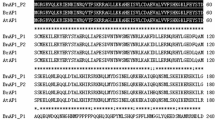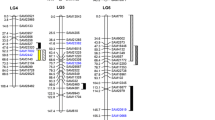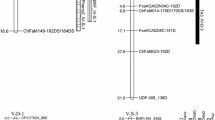Abstract
The number of days from seedling emergence to flowering (DTF) is a major consideration in sunflower breeding programs. This is a complex trait determined by the genotype, environmental conditions and interactions. Photoperiod and temperature have major effects on DTF and could be important sources of genotype× environment interaction. The objectives of this study were to locate quantitative trait loci (QTLs) associated with growing degree days (GDD) to flowering and photoperiod (PP) response in an elite sunflower population. Two hundred and thirty five F2-generation plants and their F2:3 and F2:4 progenies of a single-cross population of two divergent inbred lines were evaluated in six environments (locations, years and sowing dates) with photoperiods known to elicit a PP response between the inbred lines. Detection of QTLs was facilitated with a genetic linkage map of 205 RFLP loci and composite interval mapping. The 205 restriction fragment length polymorphism (RFLP) loci covered 1380 cM and were arranged in 17 linkage groups, which is the haploid number of chromosomes in this species. The average interval size was 5.9 cM. Six QTLs in linkage groups A, B, F, I, J and L were associated with GDD to flowering and accounted for 76% of the genotypic variation in the mean environment. QTLs in linkage groups A and B accounted for 72% of the genetic variation. QTL×environment (QTL×E) interactions were highly significant for linkage groups A, B, F and J (P<0.01). QTLs in linkage groups A and B were highly dependent on PP. Also, QTL mapping of the ratio of the GDD required by a progeny to flower at a PP of 12.1 and 15.0 h, defined as the photoperiod response (PPR), suggested that alleles at QTLs in linkage groups A and B were responsive to PP. QTLs in linkage groups F and J showed QTL×E interaction but the LOD values were not associated with PP. QTL×E interactions for additive effects were highly significant (P<0.01) for linkage groups A, B and F. QTL×E interactions for QTLs with dominant effects were significant (P<0.01) for linkage groups A, B and J. The dominant effect of QTLs in linkage group B increased in environments with a longer PP. The knowledge of how these QTLs influence the GDD for flowering and how they interact with the environment will facilitate marker- assisted selection and backcross conversion of photoperiod-sensitive germplasm.
Similar content being viewed by others
Author information
Authors and Affiliations
Additional information
Received: 7 February 2000 / Accepted: 13 June 2000
Rights and permissions
About this article
Cite this article
Leon, A., Lee, M. & Andrade, F. Quantitative trait loci for growing degree days to flowering and photoperiod response in Sunflower (Helianthus annuus L.). Theor Appl Genet 102, 497–503 (2001). https://doi.org/10.1007/s001220051673
Issue Date:
DOI: https://doi.org/10.1007/s001220051673




